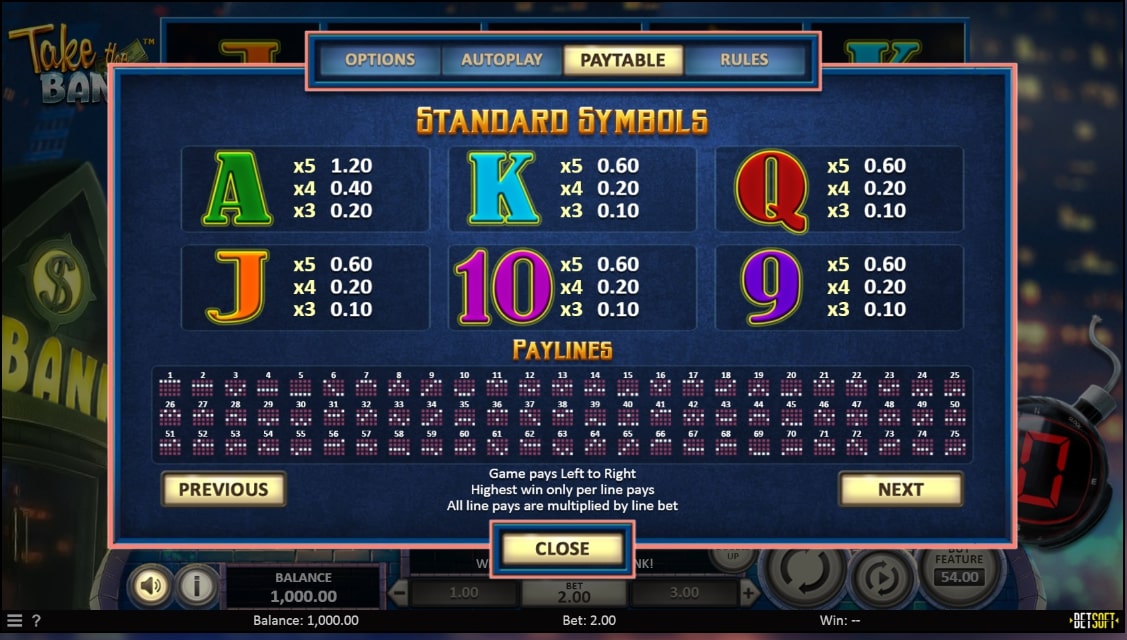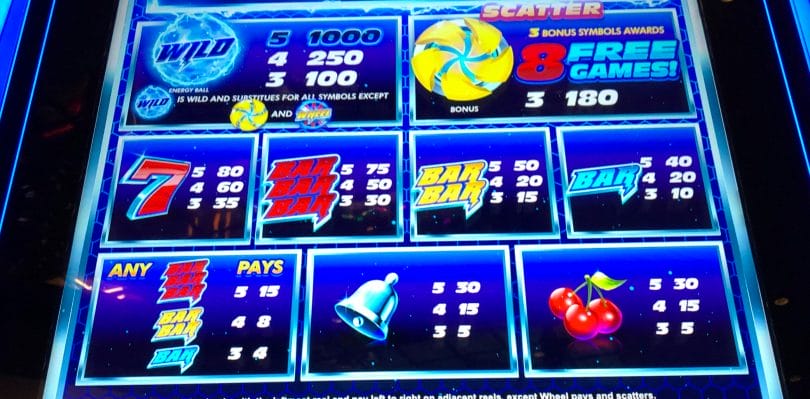How To Read A Slot Machine Pay Table
- How To Read A Slot Machine Pay Tables
- What Slot Machines Pay Best
- How To Read A Slot Machine Pay Table Video
- How To Read A Slot Machine Pay Table 2020
- Slot Machine Pay Table
- How To Read Slot Machine Payouts
Not reflected in the slot machine pay table. Compliance with the. Are slot machine in -meter readings recorded at least weekly. Time between readings may extend beyond one week in order for a reading to coincide with the end of an accounting period only if such extension is. Find out how to win at slots, how the payback percentage of a slot machine works, and how the denomination of the machine makes a difference.
Understanding how video poker pay tables work is the first step in becoming a
smart gambler-at least if you like gambling machines. How much money you get as
a payout for each hand is the determining factor for the overall payback
percentages for the VP machines.
The goal of this page is to explain what a payback percentage on a gambling
machine is, how the payback table on a video poker game determines that
percentage, and what all of this means to your gambling bankroll.
A pay table gives slot machine players helpful information regarding the game. You can access it by pressing a button marked with a question mark or an information symbol. Typically, a pay table will contain the following pieces of information. The most important feature when choosing a machine is the slots pay table. Seriously, the name of the slot is not important! It’s the pay table that should determine whether you play a certain machine. Ignore the top jackpot and concentrate on the numbers in the middle of the board. Quite a bit of information can be gleaned from reading the pay out schedule. Look for the Coin Denomination on the Slot Machine The first bit of information that you will see is the coin denomination that is required in order to play that machine.
What Is a Payback Percentage?
We’ve explained on other pages of our site what the house edge is and how it
works.
But we’ll cover it again briefly here, because it relates strongly to a
gambling machine’s payback percentage.
The house edge is a theoretical percentage of each bet that a gambler
mathematically expects to lose over the long term.
In roulette, the house edge is 5.26%. This means that if you place enough
bets (thousands+), you can expect to lose $5.26 for every $100 you wager.
In the short run, anything can happen. You might bet on a single number and
hit, winning 35 to 1 on your money. More likely, you’ll miss, and you’ll lose
100% of your bet.
But if you average out your losses over an extremely large number of spins,
you’ll eventually start getting close to the theoretical average.
Gambling writers use house edge when talking about table games.
But when they talk about gambling machines, they talk about payback
percentage.
This is the expected percentage of each bet that you’ll win back over a lot
of trials.
One of the reasons for this distinction is because table games pay off at X
to Y odds, while gambling machines pay at X for Y odds.
Here’s what that means:
If you bet $100 on a single number at the roulette table and win, you get
paid $3500. That’s 35 to 1. You keep your original bet and get the winnings on
top of it.
But if you buy $100 in credit on a slot machine or video poker machine and
wager that entire amount on a single spin or hand, you don’t get your wager
back. It’s included in the winnings.
You bet $100 on a hand of video poker and get a pair of jacks. That payoff on
that hand is 1 for 1, which means you win $100.
But you don’t get your original $100 back.
It’s gone.
In other words, the lowest paying hand in video poker is a break-even
proposition.
As a result, when you talk about gambling machines, you talk about payback
percentages.
If a slot machine has a 96% payback percentage, you can expect to win back 96
cents for every dollar you wager over time.
The Big Difference Between Slot Machines and Video Poker
Slot machines and video poker are remarkably similar. Both games deal with
combinations of symbols on a payline. Both games have payouts for specific
combinations.
The difference is that on a video poker game, we can calculate the
probability of getting a certain hand. That’s because video poker bases its
random number generator on a deck of cards.
We know the possibilities available with a deck of cards:
- You have a 1 in 52
chance of getting a specific card. - You have a 1 in 13
chance of getting a card of a specific rank. - You have a 1 in 4
chance of getting a card of a specific suit.
But on a slot machine game, you have no way of knowing the probability of
getting a specific symbol. It could be 1 in 10, 1 in 20, or 1 in 200.
How To Read A Slot Machine Pay Tables
If you know how much a result pays off, you can compare that with the
probability of getting that result to get an expected return for that
combination.
In jacks or better, you win 1 for 1 if you get a pair of jacks or higher.
You’ll see that hand roughly 20% of the time, so the expected value for that
hand is about 20 cents on the dollar.
You can calculate that for every possible outcome, including outcomes where
you win nothing (50% of the time). Add those numbers together, and you have the
theoretical expected return (payback percentage) for that pay table.
On slot machines, you’re missing that crucial piece of information-the
probability.
This is the big advantage video poker has over slot machines.
The secondary advantage is that video poker payouts are almost always better
than slot machine payouts.

An average video poker game has a payout percentage of 96% or higher.
An average slot machine game has a payout percentage of 95% or lower.
You’ll rarely find a video poker game with a payback percentage lower than
90%.
But it’s easy to find slots with payback percentages in the 75% – 80% range.
Just visit a bar, a supermarket, or an airport in Las Vegas.
The Importance of Strategy and How It Relates to Video Poker Pay Tables
The other thing to keep in mind about video poker is that the expected return
for a game assumes you’re playing each hand correctly. When you decide which
cards to discard and which ones to keep, you’re making 1 of 32 decisions. And
only one of those decisions has the highest expected return.
Suppose you have a hand which includes a pair of jacks, but it also includes
4 cards to a royal flush.
The pair of jacks is a 100% winner of even money.
To fill the royal flush, you only have 1 card out of 47 which can fill your
hand. For simplicity’s sake, we’ll call that 2%.
What Slot Machines Pay Best
But if you hit the royal flush, you’ll win 800 for 1.
Would you rather have a 100% chance of winning $1, or a 2% chance of winning
$800?
The mathematically correct say to make that decision is to multiply the odds
of winning by the size of the jackpot. That’s your expected return for that
decision.
In this case, 100% X $1 is an expected value of $1.
How To Read A Slot Machine Pay Table Video
2% X $800 is an expected return of $16.
Since $16 is clearly more than $1, the choice if obvious.
The reason we call this example “super-simplified” is because it doesn’t
account for the possibility of getting other hands.
If you keep the pair, you also have the possibility of getting 3 of a kind, 4
of a kind, or a full house.
If you keep the royal flush, you also have the possibility of getting a high
pair again on the draw.
But the odds of those are so small that you can safely ignore them. Drawing
to the royal flush is correct in this case.
remember it.
You’ll find more about video poker strategy in our comprehensive guide.
Specific Pay Tables for Specific VP Games
We obviously can’t list all the possible pay tables for every possible video
poker game on a single page. But we can provide some specific examples to
illustrate the concepts you need to be familiar with.
We’ll start with a classic pay table for Jacks or Better video poker:
| Coins/Hands | 1 coin | 2 coins | 3 coins | 4 coins | 5 coins |
|---|---|---|---|---|---|
| Royal flush | 250 | 500 | 750 | 1000 | 4000* |
| Straight flush | 50 | 100 | 150 | 200 | 250 |
| 4 of a kind | 25 | 50 | 75 | 100 | 125 |
| Full house | 9 | 18 | 27 | 36 | 45 |
| Flush | 6 | 12 | 18 | 24 | 30 |
| Straight | 4 | 8 | 12 | 16 | 20 |
| 3 of a kind | 3 | 6 | 9 | 12 | 15 |
| 2 pairs | 2 | 4 | 6 | 8 | 10 |
| Jacks or better | 1 | 2 | 3 | 4 | 5 |
The columns list the payoffs for how many coins you’ve wagered if you get a
specific hand. All the payoffs save one are multiplied by the number of coins
you’ve wagered. That’s an important distinction.
The royal flush is the top hand in almost all video poker variations. The
games are programmed to pay off at 800 for 1 for that hand, but only if you
wagered 5 coins on the hand. If you wager fewer than 5 coins, the payoff for
that hand is only 250 for 1.
This has a huge effect on your bottom line. In fact, it’s the first rule of
video poker strategy:
This isn’t true for most slot machine games-although it is true for some.
But it’s always true for video poker games.
You give up so much expected value for paying for fewer coins that you’re
always better off playing for 5 coins at lower stakes than playing for 1, 2, 3,
or 4 coins at higher stakes.
The other thing to notice about the Jacks or Better pay table is the payoff
for the full house and the flush. You’ll notice that the full house pays off at
9 for 1, and the flush pays off at 6 for 1.

On most Jacks or Better video games, the only variables on the pay table are
those 2 hands. In fact, this specific pay table is called a 9/6 Jacks or Better
pay table. An 8/5 Jacks or Better game has the same payouts on all the hands
except those two, which pay off at 8 for 1 and 5 for 1 respectively instead.
You can find other variations, but they’re rare enough that most people don’t
worry about that.
But here’s the key number for a 9/6 Jacks or Better game:
99.54%
That’s the payback percentage if you’re playing with correct strategy on
every hand.
This means the house edge for this game is only 0.46%. That’s better than
almost any other game in the casino. It’s even better than the house edge for
blackjack, which hovers around 1% at most casinos.
The payback percentage for this game drops dramatically as the payoffs chance
for Jacks or Better:
- 8/5 Jacks or Better pays
off at 97.3%. - 7/5 Jacks or Better pays
off at 96.15%. - 6/5 Jacks or Better pays
off at 95%.
How the Payback Percentage Affects Your Bottom Line
Casino managers and game designers like to forecast what kind of money a
specific game will make them over time.
As luck would have it, the math for this is easy enough that even someone
like me (and you) can understands it.
You simply multiply the average bet size by the number of bets per hour to
get the amount of action the game sees per hour.
You multiply that number by the house edge to get the amount the casino
expects to win (and you expect to lose) per hour.
An average Jacks or Better player probably gets in 600 hands per hour. (It’s
a fast-paced game.)
Let’s assume you’re playing a dollar machine at max coin, so you’re putting
$5 into action per hand.
This means you’re putting $3000 per hour into action.
On a full-pay (9/6) game, you’re expected to lose 0.46% X $3000, or $13.80.
That’s not bad for an hour of entertainment at a casino.
Deduct the cost of a couple of free premium liquor drinks from the cocktail
waitress, and you’re playing a close to even money game.
But how much can you expect to lose per hour on the 8/5 game?

The house edge for this pay table is 2.7%, which means you’re expected to
lose $81 per hour.
That’s a huge difference in your bottom line.
Play the 6/5 game, and you’re expected to lose $150 per hour.
How To Read A Slot Machine Pay Table 2020
And that’s still a better deal than most slot machines.
Conclusion
You can find pay tables for individual video poker games on the game guides
page on this site. We also offer specific strategy advice to help you get close
to the expected return for those games.

If something about our explanation of these concepts (pay tables, payback
percentages, and payouts) wasn’t clear, please contact us and let us know so
that we can update this page accordingly.
A pay table is the name for the list of payouts on a slot machine or video poker machine. The table shows for each combination of symbols and the number of coins bet how many coins (or credits) the bettor will win. The pay table feature of the slot machine displays all possible winning sequences for that specific slot game.
On older machines and some newer reel machines, the pay table is listed on the face of the machine, usually above and below the area containing the wheels. Other video machines display the pay table when the player presses a 'pay table' button or touches 'pay table' on the screen. These tables list the number of credits the player will receive if the symbols listed on the pay table line up on the payline of the machine. The pay table details where the symbols must be for the bettor to be paid. In general, the symbols must be centered directly under the payline on the machine. Video slot machines generally will only display the payline for lines that are winners.
A payline is a line (straight or zig-zagged) that crosses one symbol on each reel of a slot machine, or the combination of symbols on the slot machine reels that the player is paid out for if he has made a bet on that combination. To be winning, any combination on the reels must have at least two identical symbols in a row, and the first one must occur on the first reel unless otherwise stated. In any other case, the combination doesn't pay out.[1]
Slot Machine Pay Table
Some machines offer symbols that are 'wild' and will pay if they are visible in any position, even if they are not on the payline. These wild symbols may also count for any other symbol on the pay table.
References[edit]
How To Read Slot Machine Payouts
- ^'How to Play Slots'. CasinoObserver.com. Retrieved 2013-03-06.